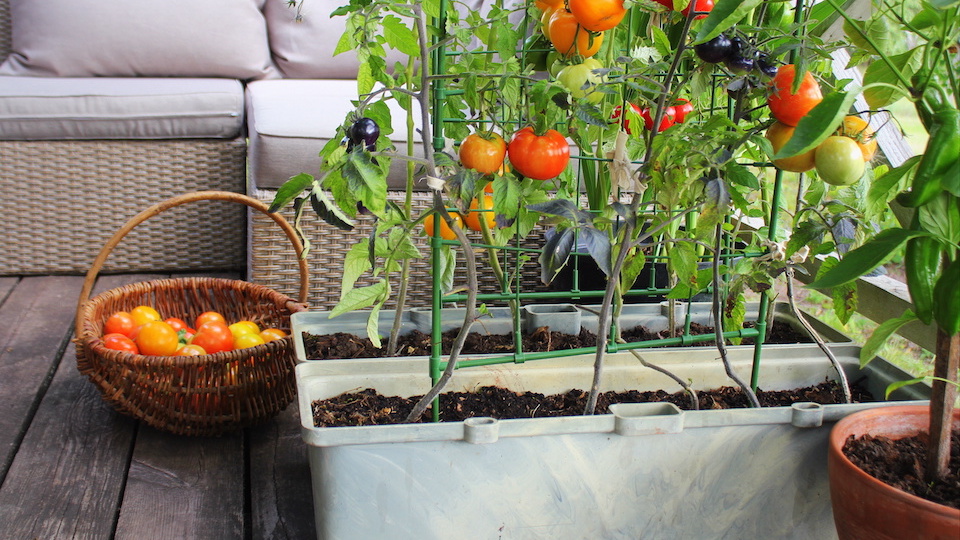While most patios and balconies are reserved for beautiful overflowing flower baskets and ornamental displays, when space is tight, it may be prudent to prioritize growing fresh, organic food for you and your family. If you haven’t already embraced the idea of container gardening, what are you waiting for?
In case you didn’t realize it, the urban gardening trend is sweeping the nation, with millions of city dwellers growing food on minuscule balconies, rooftops, and even large front stoops. Now is the time to jump on the bandwagon, as innovative garden technology is being released that is specifically catered to this small-space gardening. Hydroponics, vertical gardening systems, and raised beds make gardening accessible for everyone, even the bustling urbanite, and apartment dweller. Plus, with container gardening, you have more control over your soil and you won’t have to spend time doing back-breaking weeding (the most dreaded garden chore) With a little creativity and a few tools, you can set up the ultimate patio garden for an amazing, bountiful harvest. It’s fun, easy, practical, and will put your limited outdoor living space to good use.
Choose your location
While your options may be limited if you are gardening on your balcony or front stoop, you may have a little more space to choose from if you have a roomy patio or porch to set up your container garden. Be sure to pick a spot that receives plenty of sunlight throughout the day since veggies require a lot of light to thrive and won’t produce as much when grown in shady conditions.
Find containers
One of the biggest mistakes that people make when setting up a patio garden is thinking that they need to go to the nursery or home improvement store and buy pricey pots or containers. While this may be more appealing from a visual standpoint, if you are looking to start your garden on a budget, search around at yard sales and thrift stores for barrels, buckets, and sturdy boxes that will work just as well.
As long as your container has good drainage holes, is big enough to hold your desired veggie or fruit, and will fit in your space, you’re good to go. Plus, collecting containers from various locations will give your patio garden a funky, eclectic feel that you wouldn’t necessarily get otherwise. Remember, you can always paint the containers to match your other outdoor decor.
Other suggestions for containers:
- Make sure that you don’t use treated wood as certain chemicals can leach into your food.
- Dark containers can trap the heat and raise the temperature of the soil which could be detrimental for heat-sensitive plants.
- Clay or terra-cotta pots may fit your aesthetic, but they will often dry out too quickly. Try inserting a plastic pot inside of a terra-cotta pot to retain moisture.
Consider watering
One of the only downsides to container gardens is that pots dry out much faster than typical garden beds. While this issue can be mitigated by choosing a large, roomy pot, you will still have to water your patio garden nearly every day. If you don’t have time for this, look into self-watering pots with built-in reservoirs that release a particular amount of water and add mulch to your containers to help keep the moisture from evaporating quickly. Keep in mind, as long as you have good access to a water source, watering your plants can actually be really therapeutic and relaxing and is a good way to unwind from the stress of your life and get a little garden therapy every day.
Utilize vertical space
While it is pretty obvious that vining plants will need a trellis to grow “up” instead of “out,” many urban gardeners forget about the benefits of hanging baskets. Hanging pots are perfect for things like strawberries, cherry tomatoes, and other vining veggies to help save valuable real estate on the ground.
Be picky about your soil
Planting in an organic potting mix that is specifically designed for containers will help your garden thrive. Soil is key to success, so don’t skimp on this step by trying to use soil from your existing “in the ground” garden (if you have one). This soil is often too dense and will compact in the pot, leading to root rot and other issues.
Fertilizer
Since the dirt is often fairly sterile when you are first growing in containers, it is essential that you amend your soil with organic, granular fertilizer before you plant and then add a regular dose of liquid fertilizer every few months. This will allow your plant to get the nutrients that it needs to produce a bountiful harvest and will make up for any deficiencies in the soil.
Select the right plants
There are so many varieties of fruits and vegetables that it can be overwhelming when trying to decide what to plant. A good rule of thumb that can help you narrow down the list is to stick to patio varieties that are designed to be grown in small spaces. Many of these plants will produce as big a harvest as their full-size counterparts, but they are simply more compact and not as sprawling.
-Susan Patterson




